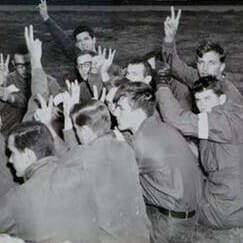On the right side of the streets, in red brick, are the Chelsea Projects. Across the streets, in white stone, is the Avenue school—from kindergarten to 12th grade—costing $45,000 per year per child. The contrast is mind-blowing!
HBO Documentary Class Divide 2016 New York City.
https://www.youtube.com/watch?v=G0Z9Vgz-aEQ
*---------*---------*---------*---------*---------*---------*

Message to the troops: Do not collaborate with the illegal immigrant detention camps
Dear Friend.In our new October PDF newsletter, we're again talking about the massive military-hosted immigrant detention camps decreed this summer by the Trump Administration. Just the idea of these concentration camps brings back memories of the forced relocation and incarceration of 120,000 Japanese Americans during World War II. While resistance has slowed them down, they are moving forward. Many of us thought something like that could never happen again, and yet, here we are. We need to reach the troops with this simple challenge: Do not collaborate with the illegal immigrant detention camps. With your help, we'll spend one penny per military service member--$20,000--on a strategic outreach campaign. Our stretch goal is two cents. Along with everything else you can do to resist this affront to humanity, please support our campaign to challenge military personnel to refuse these illegal orders. Your tax-deductible donation of $50 or $100 will make a huge difference. Also in this issue: Army Capt. Brittany DeBarros / Shutting down recruiting center; Hoisting peace flag / Presidio 27 "mutiny" 50th anniversary events / Whistleblower Reality Winner update--"So unfair" says Trump D O N A T E to our "do not collaborate" campaign
Upcoming Events
 50th anniversary events of the Presidio 27 mutiny 50th anniversary events of the Presidio 27 mutinySan Francisco, California Panel discussion on Saturday, October 13 Commemoration on Sunday, October 14 At the former Presidio Army Base More info D O N A T E to support resistance |
COURAGE TO RESIST ~ SUPPORT THE TROOPS WHO REFUSE TO FIGHT!
484 Lake Park Ave #41, Oakland, California 94610 ~ 510-488-3559
www.couragetoresist.org ~ facebook.com/couragetoresist
484 Lake Park Ave #41, Oakland, California 94610 ~ 510-488-3559
www.couragetoresist.org ~ facebook.com/couragetoresist
*---------*---------*---------*---------*---------*---------*
*---------*---------*---------*---------*---------*---------*
![PLEASE STOP KILLING US.SHUT DOWN CREECH.jpeg]()
Sunday, October 14, Noon:
CODEPINK Golden Gate Bridge Peace Walk
Stop Droning Afghanistan
17 Years: ENOUGH!
This month marks the 17th anniversary of the invasion and occupation of Afghanistan, the longest war in U.S. history. Does it make any sense that the wealthiest nation on the planet should be bombing one of the very poorest nations for 17 years, with no end in sight? "Mission Accomplished" in Afghanistan has been declared by both president Bush and president Obama…yet the US bombing continues, and over 40,000 military, mercenary and allied troops remain in that devastated nation, "the most droned place on earth." Hundreds of thousands of Afghans have been killed, and tens of thousands live with amputations and other permanent injuries. CODEPINK says: ENOUGH!
Join us this Sunday in solidarity with the people of Afghanistan. Wear a sky blue scarf (if you have one), in support of the Afghan Peace Volunteers heroic campaign to end war globally.
Learn more at: www.OurJourneyToSmile.com
Wear pink or come as you are, but come in the spirit of unity for nonviolence.
Bring signs ( 2x3 ft. or smaller)......wooden sticks/poles permitted.
We hope to see you there!
Renay, Susan, Laura, Nancy, Ellen, Fred, Carol, Paul, Michael and Toby
(Martha's in DC. Toby's daughter, Margeaux, is visiting and hopefully will come too!)
11:45 am: Gather at the SF or Marin end of the eastern walkway of the Golden Gate Bridge.
Parking available on all 4 "corners", just remember to take
the last exit on hwy 101 as you approach the bridge, or the
first exit after you leave the bridge.
12:00 pm: Walk on the eastern walkway from the north or south ends, to converge in the middle for Peace in Afghanistan vigil.
1:00pm Rally on SF side after the bridge walk:
Tentative plan for a 5 min. DIE-IN on the plaza to memorialize all those lost lives from this useless 17 year war.
Bring your children, your mothers, friends, relatives and your LOVE!
BE GREEN AND CARPOOL
BE GREEN AND CARPOOL
See http://tripplanner.transit.511.org for public transit options.
Golden Gate Transit Buses 10, 70, 80
and SF Muni Bus 28 stop at the bridge (SF side).
FMI & carpooling: Toby, 510-215-5974
ratherbenyckeling@comcast.net
*---------*---------*---------*---------*---------*---------*
A soldier's tale of bravery and morality

Chris Hedges interviews former combat veteran and US Army officer Spenser Rapone about bravery and morality. The second lieutenant was given an "other than honorable" discharge June 18 after an army investigation determined that he "went online to promote a socialist revolution and disparage high-ranking officers," and thereby engaged in "conduct unbecoming an officer."
https://www.rt.com/shows/on-contact/439962-combat-veteran-bravery-morality/
*---------*---------*---------*---------*---------*---------*
*---------*---------*---------*---------*---------*---------*
*---------*---------*---------*---------*---------*---------*

Pardon Whistleblower Reality Winner
Hi Bonnie.On June 3, 2017, NSA contractor Reality Leigh Winner was arrested and charged under the Espionage Act for providing a media organization with a single five-page top-secret document that analyzed information about alleged Russian online intrusions into U.S. election systems. Reality, who has been jailed without bail since her arrest, has now been sentenced to five years in prison. This is by far the longest sentence ever given in federal court for leaking information to the media. Today, she is being transferred from a small Georgia jail to a yet-unknown federal prison. Several months before her arrest, the FBI's then-Director James Comey told President Trump that he was (in the words of a subsequent Comey memo) "eager to find leakers and would like to nail one to the door as a message." Meanwhile, politically connected and high-level government officials continue to leak without consequence, or selectively declassify material to advance their own interests. Join Courage to Resist and a dozen other organizations in calling on President Trump, who has acknowledged Winner's treatment as "so unfair," to pardon Reality Winner or to commute her sentence to time served. D O N A T E
Upcoming Events
 Feds holding last public hearing on draft registration Feds holding last public hearing on draft registrationLos Angeles, California Thursday, September 20 At California State University Los Angeles More info  50th anniversary events of the Presidio 27 mutiny 50th anniversary events of the Presidio 27 mutinySan Francisco, California Panel discussion on Saturday, October 13 Commemoration on Sunday, October 14 At the former Presidio Army Base More info D O N A T E to support resistance |
COURAGE TO RESIST ~ SUPPORT THE TROOPS WHO REFUSE TO FIGHT!
484 Lake Park Ave #41, Oakland, California 94610 ~ 510-488-3559
www.couragetoresist.org ~ facebook.com/couragetoresist
484 Lake Park Ave #41, Oakland, California 94610 ~ 510-488-3559
www.couragetoresist.org ~ facebook.com/couragetoresist
*---------*---------*---------*---------*---------*---------*


